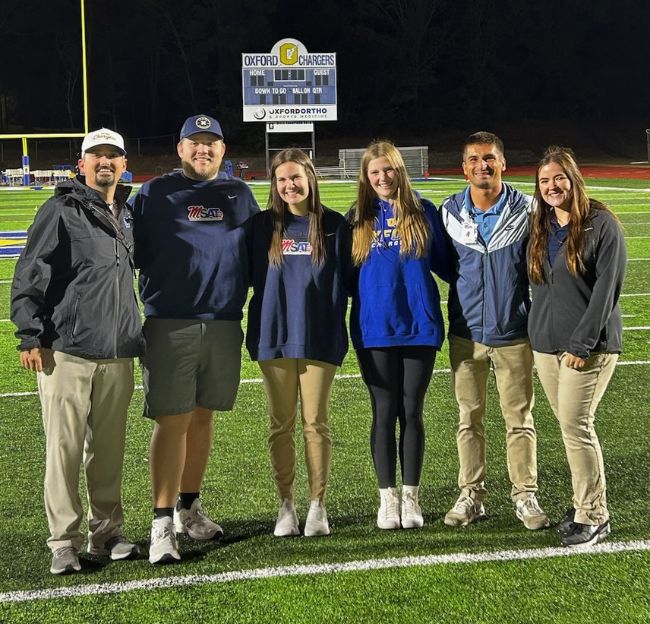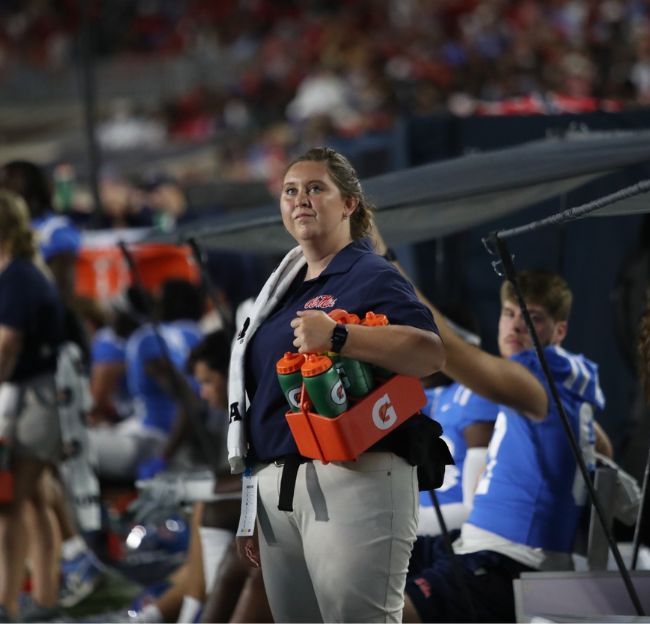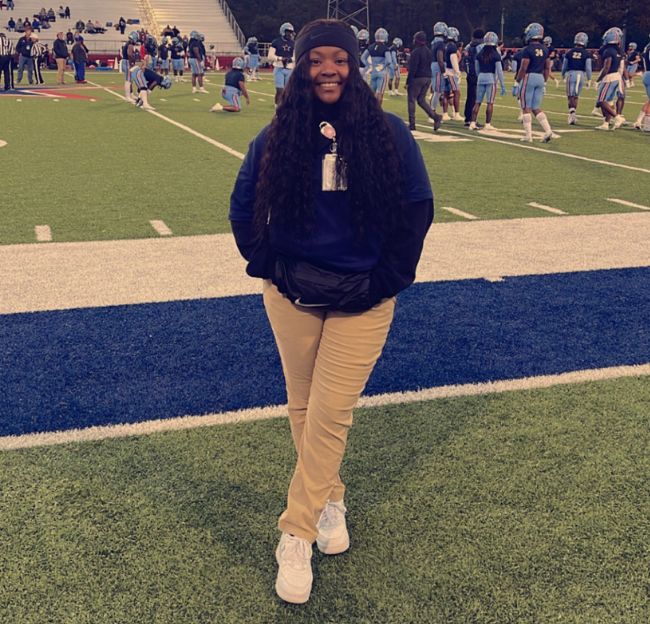Athletic Training, M.S.
Get the on-hands experience you need to be one of the top athletic trainers in your field and region.
- Home
- Academic Programs
- Master of Science in Athletic Training
About the Master of Science in Athletic Training
The Master of Science in Athletic Training (MSAT) is one of the newest programs in Mississippi and the Southeastern Conference. The MSAT includes a multitude of experiences that will create a well-rounded athletic training professional. This program gives students academic and clinical opportunities to work with a wide range of partners, including:
- Ole Miss Athletics
- Area high schools
- Professional sports teams
- Hospitals
- Clinics
- Physician’s offices, and more.
The MSAT program starts in the summer (end of May) and is a designed to be a two-year, 54 credit hour, lockstep cohort program.
On this Page…
Program Information
Degree
M.S. in Athletic Training
Emphases
N/A
Required Credit Hours
54
Program Type
Master's Program
Program Location
School
Duration
Two years
Explore Everything the M.S. in Athletic Training Has to Offer
Clinical Education
Students involved in the UM-MSAT will gain clinical knowledge and experience through a broad spectrum of opportunities that include both traditional and non-traditional settings throughout the course of the 2-year program.
These clinical experiences will allow the UM-MSAT students the opportunity to apply what has been learned in the classroom to patient care while working under the supervision of an approved healthcare provider. Refer to the MSAT Student Handbook for more information on clinical experiences.
Clinical Experience Expectations
All UM-MSAT students must complete a variety of clinical experiences in accordance with CAATE requirements. These clinical experiences may include exposure to a vast number of settings such as:
- College/university,
- High school,
- Recreational/club sports,
- Military, and
- Industrial settings
The experiences allows students to participate in hands-on style of learning and develop a skill set that that is applicable to all populations regardless of age, skill, socioeconomics or identity. Each setting will deliver the skills and proficiencies to allow students to fully understand the continuum of care defined within the domains of Athletic Training as necessary for an entry-level Certified Athletic Trainer.
Here's how the Clinical Experience works:
- Clinical experiences are assigned by the Clinical Education Coordinator, with input from the Program Director. Clinical experiences are based on the needs and aspirations of each athletic training student.
- Certified and licensed Athletic Trainers or Physicians at an affiliated site will supervise each clinical experience.
- Preceptors trained through the UM-MSAT program will be assigned to each UM-MSAT student.
- All UM-MSAT students will be allowed to perform skills learned within the classroom in real-time situations under the supervision of their designated preceptor. This provides the opportunity for students to take didactic skills and translate them in the clinical setting on patients of all backgrounds.
- In some cases, students may be required to perform skills in a simulation to ensure competency in their ability to perform the skill. Students may also be exposed to learning opportunities supervised by health care provider other than athletic trainers or physicians known as supplemental clinical experiences.
The purpose of clinical experiences for UM-MSAT students is to further observe real-life patient care and engage in their learned skills. The UM-MSAT students may utilize any “down-time” within the clinical setting to further practice clinical skills or other tasks designated by the clinical preceptor as well as discuss learning objectives or other relevant topics with their clinical preceptor or fellow students.
Professional Development
Students become members of the National Athletic Trainers’ Association as well at the Mississippi Athletic Trainers’ Association and actively participate in professional conferences, service activities, and the University of Mississippi Athletic Training Club.
Transfer students must go through the SAME application process as all other students. Further consideration towards potential transferable credits will be evaluated on a case-by-case basis.
Students interested in potential transferable credit opportunities will have to provide documentation that demonstrates coursework aligns with the requirements of the UM-MSAT curriculum and associated accreditation standards embedded within each course. There is no guarantee of acceptance for transferable credits.
MSAT Tuition & Fees
For cost of attendance please visit the Office of Financial Aid.
MSAT Associated Program Costs
Associated Program Costs can be found in the MSAT Program Handbook.
Financial Aid & Scholarships
For information on scholarships and graduate assistantships, please visit the following links:
Admission
The MSAT is a two-year, 54-credit-hour, lockstep cohort program. The program follows a rolling admissions process, with new cohorts admitted annually to begin each full summer session.
Admission Requirements
- Completed application to Athletic Training Centralized Application System ATCAS
- Completed application to the UM Graduate School
- Bachelor’s degree
- A minimum 3.0 cumulative grade-point average
- A minimum grade of C or better on all prerequisite courses.
- Technical Standards Attestation Form – Each student is required to a submit a completed copy of the Technical Standards
Prerequisite Course Requirements:
Students must complete at least one course in each of the following prior to matriculation into the MSAT program.
- Biology
- Chemistry
- Physics
- Psychology
- Statistics
- Biomechanics/Kinesiology
- Medical Terminology
- Exercise Physiology
- Human Anatomy
- Human Physiology
International Students
Additional required documentation for applicants whose native language is not English will be based on university standards. Please refer to the Office of International Programs for a more detailed explanation of those standards.
The University of Mississippi Master of Science in Athletic Training program is accredited by the Commission on Accreditation of Athletic Training Education (CAATE).
MSAT Program Handbook
Find a comprehensive overview of the M.S. in Athletic Training program, including admissions, curriculum, academic policies, program costs, and essential student resources.Find Courses in the M.S. in Athletic Training
AT 600: Emergency Management in AT
This course will develop the essential knowledge and skill application needed for the prevention, assessment, and treatment of acute and emergent illnesses and injuries within the profession of athletic training. Content includes emergency procedures, therapeutic taping, bracing, splinting techniques, and referral decisions for emergent conditions.
- Athletic Training/Trainer
AT 607: General Medicine & Pharmacology
This course explores a systems-based approach in the evaluation, clinical diagnosis, and management of general medical conditions. Students will gain knowledge and functional ability in the diagnosis and management of medical problems by utilizing clinical data, laboratory and diagnostic results. Students will also gain an understanding of pharmaceutical use in the management of general medical conditions across the life span.
- Athletic Training/Trainer
AT 660: Sports Performance
This course serves as an overview of athlete sports performance. Students will be introduced to basic strength and conditioning concepts as well as sports nutrition and psychology.
- Athletic Training/Trainer
What does MSAT look like on the job market?
Median income for Athletic Trainers in 2023.
Athletic Trainers employed in the U.S. in 2022.
Projected job growth over the next 10 years for Athletic Trainers—much faster than average.
Of Athletic Trainers are employed in athletics. But because of their success in prevention, rehabilitation, and risk management, the AT job market is constantly expanding.
Hands-On Experience That Will Change Your Life

Tanner Hunter is a Second Year MSAT Student
"Oxford varsity football won our first round playoff game in double overtime. This was extra special because I didn't expect to get done with an ACES prep course in time to make the game, but I made it at halftime to watch the Chargers pull off the win!"

Sarah Martin Had Her Clinical Rotation in the Fall of 2023
"My favorite experience from my clinical rotation was getting to experience the win against LSU with the team."

Topanga Taylor Loved Her Summer Immersion
"I enjoyed working with the Memphis State Tigers. My preceptor Darrell Turner took me under his wing and showed a great example on how to operate in athletics. I was able to work alongside different legends and make a connection. The Tigers welcomed me into their family and treated me like they've known me forever. I got to experience and see a lot of new injuries and new ways to better myself in this profession."
Where Do Athletic Trainers Work?
- Public and private secondary schools, colleges and universities, professional and Olympic sports
- Youth leagues, municipal and independently owned youth sports facilities
- Physician practice, similar to nurses, physician assistants, physical therapists and other professional clinical personnel
- Rural and urban hospitals, hospital emergency rooms, urgent and ambulatory care centers
- Clinics with specialties in sports medicine, cardiac rehab, medical fitness, wellness and physical therapy
- Occupational health departments in commercial settings, which include manufacturing, distribution and offices to assist with ergonomics
- Police and fire departments and academies, municipal departments, branches of the military
- Performing arts including professional and collegiate level dance and music
Meet Our Faculty and Staff
Susan Wehring
- Instructional Associate Professor of Athletic Training and Program Director of Athletic Training
Corbit Franks
- Assistant Professor and Clinical Education Coordinator of Athletic Training
Heather Landry Shirley
- Assistant Professor of Athletic Training
Camille Toles
- Administrative Coordinator I
Stay up to date with MSAT!
Follow us on Instagram to stay in the know.
Next Steps
Explore Affordability
We have a variety of scholarships and financial aid options to help make college more affordable for you and your family.
Apply to the University of Mississippi
Are you ready to take the next step toward building your legacy?
